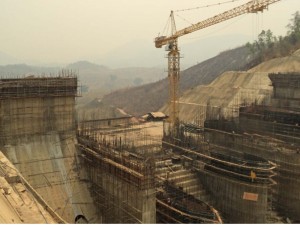Development Projects Fuel Conflict in Ethnic Nationality Areas
By Burma Partnership • May 13, 2013 “Local communities and internally displaced persons are concerned that the dam plans will lead to increased militarization, human rights abuses, environmental destruction and loss of local livelihoods,” said the environmental lobby group, China Dialogue, talking about dam construction on the Salween River earlier this week. In recent weeks, there have been several examples of development projects directly contributing to armed conflict and militarization in ethnic nationality areas.
“Local communities and internally displaced persons are concerned that the dam plans will lead to increased militarization, human rights abuses, environmental destruction and loss of local livelihoods,” said the environmental lobby group, China Dialogue, talking about dam construction on the Salween River earlier this week. In recent weeks, there have been several examples of development projects directly contributing to armed conflict and militarization in ethnic nationality areas.
Fighting renewed between the Democratic Karen Benevolent Army (DKBA) and the government-backed Border Guard Forces in late April after the Burma Army ordered the DKBA to leave the area near the Hat Gyi hydropower dam site in Karen State. The DKBA refused to comply. Clashes have ceased but tensions remain high with the Karen National Union Brigade 5 also opposing the construction of the dam.
Earlier this year, the Burma Army ordered the Shan State Army-North (SSA-N) to vacate their base beside the Salween River, which they have occupied under the terms of a ceasefire agreement signed in January 2012. Clashes between the SSA-N and the Burma Army have multiplied since late February. The Burma Army is amassing troops to force the SSA-N to leave its territories near the Salween River, where a Chinese-backed mega dam project is set to be built. The fighting has already led to a humanitarian crisis with over one thousand people displaced.
In addition, conflict has renewed this week between the Burma Army and the Shan State Army-South (SSA-S) forcing 1,000 villagers to flee across the China border. Major Sai Lao Hseng said to the Irrawaddy, “the government army has not obeyed the ceasefire, which is a part of the peace process. So we feel like the ceasefire is just a peace accord on paper. It doesn’t reflect the reality on the ground.”
Civil society also raised concerns with Saw Alex from the Karen Environmental and Social Action Network warning that an increase in resource-grabbing by military-supported investment projects could lead to a flare-up in the ethnic conflict.
The peace process is stagnating. The government continues with its rhetoric to push for development in ethnic nationality areas before any political dialogue with ethnic armed groups takes place. As seen in Karen and Shan States, development projects exploiting ethnic areas’ resources, initiated before the root causes of the conflict have been addressed, and without social and environmental impact assessments and local population involvement in decision-making, will only fuel further outbreaks of conflict.
Development agencies, donor countries and international financial institutions must strictly follow a “do no harm” policy. They must ensure best practices are fully implemented in order to ensure their aid, investment and programs do not exacerbate ethnic conflicts.
Tags: Burma Partnership, Dams, Development ProjectThis post is in: Blog
Related PostsBurma Partnership Celebrates Continuing Regional Solidarity for Burma and Embraces the Work Ahead for Progressive Voice
Burma Army Displays Blatant Disregard for 21st Century Panglong Peace Process
Ann Din Coal Power Plant: Local Movement and Action to Preserve and Protect Natural Resources and Land: Mon IDP Report Case Study #4
Latest Human Rights Abuse Case Demonstrates Urgent Need to Reform the Myanmar National Human Rights Commission
Human Rights Far From Guaranteed as US Sanctions on Burma Are Removed









 All posts
All posts